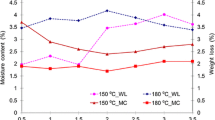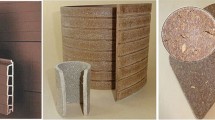Abstract
Thickness swelling (TS), water absorption (WA) and edge swelling (ES) of 20 mm flat-pressed wood–plastic composites (WPC) panels with a wood flour (WF) content of 50 and 70 % manufactured using an industrial single-daylight press and samples of a high pressure laminate (HPL) compact panel were determined after immersion in cold water according to EN 317 and boiling water according to EN 438 in order to propose, describe and verify a method to (1) measure TS, WA and ES more quickly than by applying EN 317 and (2) to make the properties of WPC and HPL comparable to each other. TS, WA and ES of WPC panels determined after immersion in cold and boiling water were found to correlate with a correlation coefficient of 95–99 % equating 24 h (EN 317) and 0.5 h (EN 438) to factor x. Properties of WPC panels with WF content of 50 % were found to be comparable, respectively superior to those of HPL.
Zusammenfassung
Mit der Absicht, eine Methode zur (1) schnelleren Bestimmung von Dickenquellung (TS), Wasseraufnahme (WA) und Kantenquellung (ES) als nach EN 317 vorzuschlagen, zu beschreiben und zu überprüfen sowie (2) diese Eigenschaften mit denen einer Hochdruck-Schichtstoffplatte (HPL) vergleichbar zu machen, wurden 20 mm dicke WPC-Platten mit einem Holzanteil von 50 und 70 % nach dem Flachpressverfahren auf einer industriellen Ein-Etagenpresse hergestellt und deren TS, WA und ES nach Kaltwasserlagerung (EN 317) und Kochwasserlagerung (EN 438) bestimmt. TS, WA und ES von WPC-Platten nach Kalt- und Kochwasserlagerung wurden als miteinander korrelierend (Korrelationskoeffizient 95–99 %) gefunden, wenn 24 h (EN 317) und 0,5 h (EN 438) gleich x gesetzt werden. Die Eigenschaften von WPC-Platten mit einem Holzanteil von 50 % waren vergleichbar mit denen von HPL.

Similar content being viewed by others
References
Benthien JT, Thoemen H (2013) Effects of agglomeration and pressing process on the properties of flat pressed WPC panels. J Appl Polym Sci. doi:10.1002/app.39155
Benthien JT, Thoemen H, Weissmann V, Korte H (2009) WPC-Herstellung nach dem Flachpressverfahren: Einfluss der Rohstoffkomponenten und Herstellungsparameter auf die physikalischen und mechanischen Eigenschaften. In: 3rd German WPC Congress, Cologne, Germany, 2–3 Dezember 2009
Benthien JT, Thoemen H, Maikowski S, Lenz MT (2012) Resistance of flat-pressed wood-plastic composites to fungal decay: effects of wood flour content, density, and manufacturing technology. Wood Fiber Sci 44(4):422–429
Chaharmahali M, Tajvidi M, Kazemi Najafi S (2008) Mechanical properties of wood plastic composite panels made from waste fiberboard and particleboard. Pol Compos 29(6):606–610
Clemons CM, Ibach RE (2004) Effects of processing method and moisture history on laboratory fungal resistance of wood-HDPE composites. For Prod J 54(4):50–57
Dominik M (2006) Continuous process for manufacturing natural-fibre-filled plastic boards. Kunststoffe Int 2:88–91
Gardner DJ, Han Y, West C (2011) FRP-reinforced wood plastic composites panels for structural applications. In: 11th International conference on wood and biofiber plastic composites, Madison, 16–18 May 2011
Maué F (2005) Herstellung von Hightech-Holzplatten aus Holz-Kunststoff-Verbundwerkstoffen. In: 1st German WPC conference, Cologne, Germany, 8–9 November 2005
Vos DJ (1998) Engineering properties of wood-plastic composite panels. MS Thesis. University of Wisconsin, Madison
Acknowledgments
The authors would like to thank Dr. Helmut Roll (Pallmann Maschinenfabrik GmbH & Co. KG, Zweibrücken, Germany); Mr. Thomas Voigt (Dr. Schürmann Kunststoffe GmbH, Upahl, Germany); Mr. Niels Julskjær and Mr. Søren Vangsgaard (Kompan A/S, Odense, Denmark) for supporting this study.
Author information
Authors and Affiliations
Corresponding author
Rights and permissions
About this article
Cite this article
Benthien, J.T., Ohlmeyer, M. Thickness swelling and water absorption of WPC after immersion in cold and boiling water. Eur. J. Wood Prod. 71, 437–442 (2013). https://doi.org/10.1007/s00107-013-0695-2
Received:
Published:
Issue Date:
DOI: https://doi.org/10.1007/s00107-013-0695-2




